699 Search Results for communication book
October 20, 2012
by Carole Zangari -
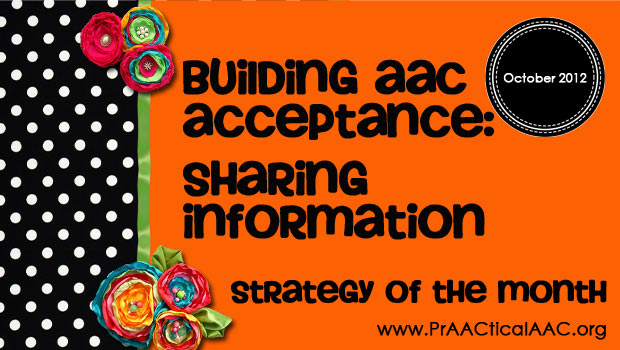
While there are certainly attitudinal barriers to AAC, it’s also true that sometimes the people we are trying to influence just need more information. Sounds simple, right? Not exactly. Especially when we consider these factors. Adult learners prefer to chart their own course to learning new things rather than have others lay that out for them. Our behaviors are most likely to change when we discover solutions for ourselves, as opposed to following directions that others give to us. We have a limited amount of time to guide others to the information they need. Here are some things that have worked for us. Develop a bank of educational materials that pertain to the topics that you face most often in your clinical work. Create resource files for general topics, such as the empirically-supported benefits of AAC, and specific topics, such as the evidence base for using SGDs with individuals who... [Read More...]
October 20, 2012
by Robin Parker -
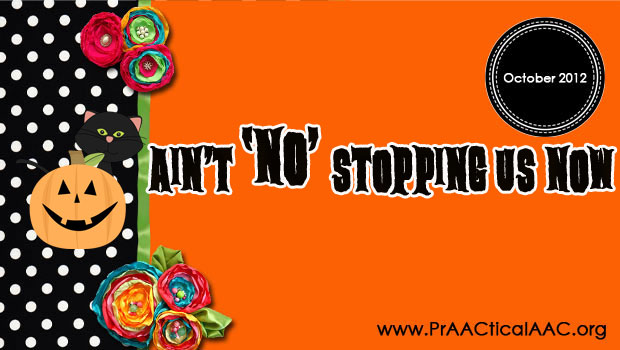
Sometimes saying ‘no’ to the demands of the day actually helps us rejuvenate and allows us to be more productive. Saying ‘no to false information helps us to advocate for ourselves. The ‘no’ topic seems to be trending now. There have been quite a few blog posts and comments about the issue (Just Say No, How and When to Give Your Students A Break). We are so glad that this topic is getting more focus. Of course everyone agrees that ALL people have the right to say ‘no’. But it is not always so simple. There are many types of ‘no’. There is the outright ‘no’, the ‘no’ to more work, the ‘no’ for disagreement, the ultra important ‘NO’ to unwanted touching, and many more. And depending upon how you say ‘no’ is the difference between it being accepted or… NOT. The issue of saying ‘no’ gets more complicated when... [Read More...]
October 19, 2012
by Carole Zangari -
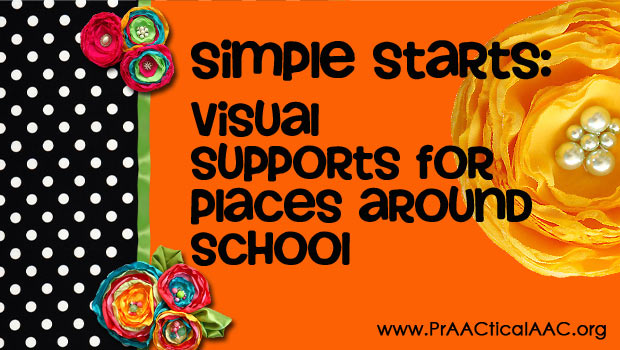
Simple Start is a series of posts that discuss AAC-related tools and strategies that are rather quick and easy to make or implement. Whether you are brand new to AAC or relatively experienced, we all come to a point where complicated just won’t do. – In our first Simple Start, we’re talking about Picture Card Rings, a type of visual support for language comprehension. The National Professional Development Center on Autism Spectrum Disorders defines visual supports as any tool presented visually that can help a person function in their day-to-day life. In this case, we’ve narrowed it down to the specific case of using photos of places around a school to help the student better understand words like ‘cafeteria’ and ‘clinic.’ — Most people with AAC needs do not require a communication system that represents language through photographs. This is a very good thing since there is no way to... [Read More...]
October 17, 2012
by Carole Zangari -
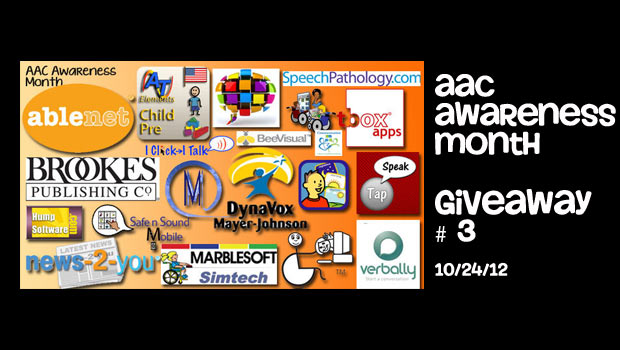
We have been having a wonderful time with our prAACtical celebration! So far, we’ve awarded prizes to 25 different AAC-lovers, thanks to the generosity of a lot of companies and individuals. What a terrific group! Ablenet, Inc Abilipad Alexicom Avaz BeeVisual Dynavox/Mayer Johnson Gail Van Tatenhove, PA Hump Software iClick iTalk MarbleSoft News-2-You Patient Provider Communication Paul H. Brookes Publishing Company RJ Cooper Safe N Sound Mobile Say It with Symbols Silver Lining Multimedia SpeechPathology.com TapSpeak TherapyBox/TBoxApps Verbally How Does It Work? We use Rafflecopter to administer the giveaways. All entries made through there will be counted toward our drawings. We’re holding four drawings spaced throughout the month, and will draw two more sets of winners, one on October 24 and the other on October 31. Prizes are randomly assigned to each winner. We’ll send an email to each one letting them know what they’ve one. The winners will have... [Read More...]
October 16, 2012
by Carole Zangari -

“If I am not for myself, then who will be for me? And if I am only for myself, then what am I? And if not now, when?” (Rabbi Hillel) Join the 4th Annual 24-Hour Global AAC Chat tomorrow, which starts tomorrow October 17 at 8:00 am (Eastern Time, USA) and runs until Thursday morning. The AAC Chat will continue nonstop for 24 hours on Skype, Facebook, and Twitter. Judy Bailey and Justin Bergers have organized this year’s event. Join people from around the globe in a chat session, by tweeting, or posting to a web page. Share information and resources. Share a story, ask a question, or encourage someone on their AAC journey. Make new friends. Connect with others. Everyone with an interest in AAC is welcome. Here’s how you can support this effort: Skype: Send your Skype name to info@aacawareness.org or contact Judy Bailey directly (via Skype at judy.bailey3) to... [Read More...]
October 10, 2012
by Carole Zangari -
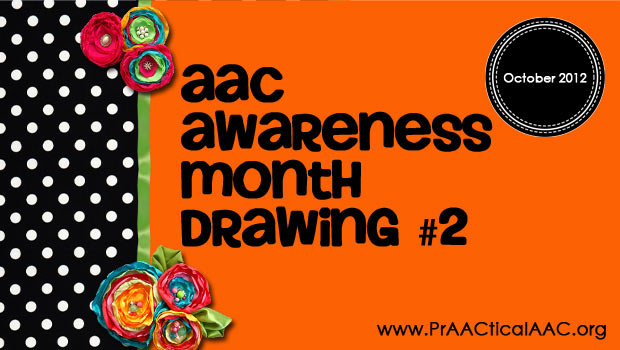
We’re bAACk with another giveaway to celebrate AAC Awareness Month, made possible by the very generous people at the organizations listed below: Ablenet, Inc Abilipad Alexicom BeeVisual Dynavox/Mayer Johnson Gail Van Tatenhove, PA Hump Software iClick iTalk MarbleSoft News-2-You Patient Provider Communication Paul H. Brookes Publishing Company RJ Cooper Safe N Sound Mobile Say It with Symbols Silver Lining Multimedia SpeechPathology.com TapSpeak TherapyBox/TBoxApps Verbally How Does It Work? We use Rafflecopter to administer the giveaways. All entries made through there will be counted toward our drawings. We’re holding three additional drawings this month, and will pick winners on October 17, 24, and 31. Prizes are randomly assigned to each winner. We’ll send an email to each one letting them know what they’ve one. The winners will have 5 days to respond to our email. You’ll need to be a good sport to play along because we’re not going to get... [Read More...]
October 5, 2012
by Robin Parker -

We are incredulous! In a GREAT way, an AWESOME way, an EPIC way. The generosity of the AAC community has honestly made us speechless for a moment. Then we quickly had a lot to say about AAC Awareness Month and the PrAACtical Celebration. So ENTER THE GIVEAWAY BECAUSE: The GIVEAWAYS are awesome! You can learn about a lot of new resources! You can get AAC Awareness ideas. You can help promote AAC Awareness Month! It’s fun to try and win! There are a lot of giveaways! You can learn about cool companies to ‘like’ on facebook. You or someone you know may be surprised. AAC Awareness is important! The GIVEAWAYS are awesome! Ablenet, Inc Abilipad Alexicom BeeVisual Dynavox/Mayer Johnson Gail Van Tatenhove, PA Hump Software iClick iTalk MarbleSoft News-2-You Patient Provider Communication Paul H. Brookes Publishing Company RJ Cooper Say It with Symbols Silver Lining Multimedia SpeechPathology.com TapSpeak... [Read More...]
October 4, 2012
by Carole Zangari -
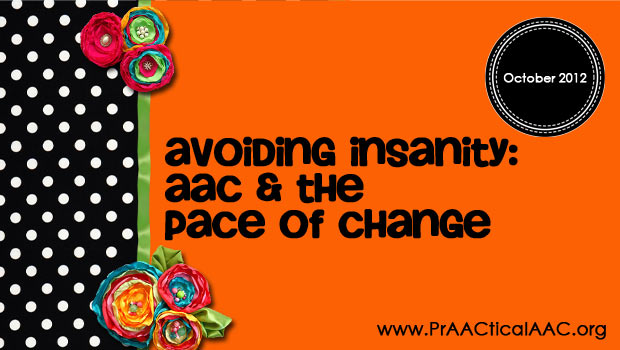
Although the field of AAC emerged only in the last few decades, the notion of communicating in alternative ways is centuries old. In classical times, the use of manual communication by deaf individuals was referred to by Plato and documented in Europe during the Middle Ages. In North America, American Indian Hand Talk evolved over generations to allow cross-cultural communication between speakers of diverse languages. As a clinical/educational field, AAC has been described as evolving through a “bottom-up” mechanism. Individuals with congenital conditions that prevented the development of intelligible speech invented their own communication systems long before teachers, therapists, and clinicians formalized instruction in alternative modes of expression. AAC users growing up in the forties and fifties tell of communicating through grunts, vocalizations, “air writing,” and eye movements, which, though effective in some contexts, were maddening in their limitations. Individuals who were fortunate enough to have access to habilitative and... [Read More...]
October 1, 2012
by Carole Zangari -
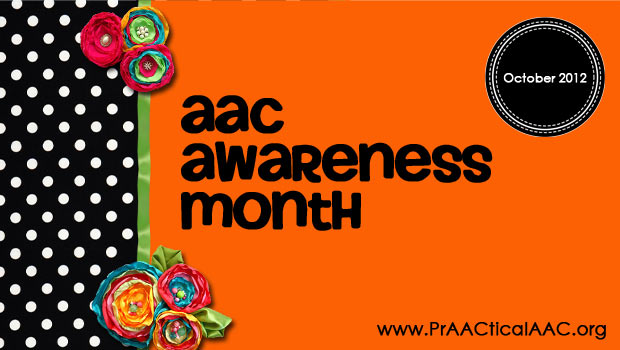
It’s a prAACtical celebration! Thanks to the generosity of a lot of companies and individuals, we’re hosting some AAC Surprise Giveaways in honor of AAC Awareness Month. As you can see, we’ve had lots of prizes donated from these wonderful folks: Ablenet, Inc Abilipad Alexicom BeeVisual Dynavox/Mayer Johnson Gail Van Tatenhove, PA Hump Software iClick iTalk MarbleSoft News-2-You Patient Provider Communication Paul H. Brookes Publishing Company RJ Cooper Say It with Symbols Silver Lining Multimedia SpeechPathology.com TapSpeak TherapyBox/TBoxApps How Does It Work? We use Rafflecopter to administer the giveaways. All entries made through there will be counted toward our drawings. We’re holding four drawings spaced throughout the month, and will draw winners on October 10, 17, 24, and 31. Prizes are randomly assigned to each winner. We’ll send an email to each one letting them know what they’ve one. The winners will have 5 days to respond to our email.... [Read More...]
August 25, 2012
by Robin Parker -

We live in Florida and there are lots of general summer storms. They can be very loud and dark. There are also many hurricane warnings (like now for Hurricane Isaac). Many children and adults with communication challenges can become upset or anxious because of the loud noises, the change in routines, and/or the heightened state of anxiety that is usually around the house or community. Because of this we are often asked to help find visual support resources. Here are some great prepared visual support stories and resources that we use: Bad Weather Tips and Story by Hands in Autism Hurricane Preparedness More Hurricane Preparedness Thunder/Lightning Storms Thunder Box Sometimes though the prepared supports do not meet the needs for specific learners. Here are our tips for developing your own storm visual supports and resources Creating Personal Participation Stories Use language of the story that is at the... [Read More...]









